Abstract
A series of large-pore mesoporous silica (LPMS)-supported CrOx catalysts were synthesized by hydrothermal and impregnation methods and tested for ethane dehydrogenation in the presence of CO2 as an oxidant. To assess the effect of hydrothermal temperature treatment on the characteristics of LPMS support, different hydrothermal temperatures (100–160 °C) were studied and optimized. The optimum support was then loaded with different amounts of chromium (0, 2, 4, 8, and 11 wt % Cr). The obtained catalysts were characterized by different techniques such as XRD, BET, TEM, SEM, XPS, FTIR, and diffuse reflectance UV-Vis spectroscopy. The characterization results indicated that the sample hydrothermally treated at 130 °C exhibited the highest pore volume, a narrow pore size distribution, and a moderate BET surface area. Chromium species with various oxidation states including Cr3+, Cr6+, and α-Cr2O3 were detected in all synthesized Cr(y)/LPMS-130 catalysts. A lower Cr content resulted in the formation of Cr6+, whereas a higher Cr content dominated the α-Cr2O3 on the surface of the catalyst. Among the synthesized catalysts, the Cr(4)/LPMS-130 catalyst showed the highest Cr6+/Cr3+ ratio, indicating a good dispersion of chromium species along with a fine particle size. The ethane conversion and ethylene selectivity were 50.5 and 91.1% for Cr(4)/LPMS-130, respectively. Carbon dioxide was believed to supply enough lattice oxygen to maintain the Cr species at a higher oxidation state and to consume the hydrogen resulting from ethane cracking by a reverse water gas shift reaction.
1. Introduction
The high market demand for ethylene derivatives such as polyethylene, ethylene oxide, ethylene glycol, ethylene dichloride, and ethylbenzene, has made ethylene one of the essential intermediate feedstocks in the petrochemical processes [,,]. Commercially, ethylene is produced by thermal cracking of either naphtha or ethane (C2H6). These are energy-consuming processes that promote rapid coke formation in addition to huge amounts of CO2 emission [,,]. Ethylene can be also obtained by oxidative dehydrogenation (ODH) of ethane. This reaction has many advantages; for example, ethane with high conversion can be achieved at relative low reaction temperatures, which means there is no need for heat supplying. Furthermore, the presence of the oxidant in the ODH reactions reduces the coke formation. Oxygen [], CO2 [], and N2O [] have been employed as oxidants for ODH of ethane. However, due to the exothermic nature of ODH of ethane by oxygen, this reaction required an efficient heat removal system, the selectivity needed to be controlled to avoid over-oxidation of ethane and ethylene. On the other hand, utilizing CO2, which is one of the primary greenhouse gases, as a soft oxidant for dehydrogenation of ethane, seems very attractive and promising due to its availability and low cost. Additionally, utilization of CO2 to synthesize more beneficial products instead of releasing it into the atmosphere is an added value. The main obstacle of ODH of ethane with carbon dioxide is the low ethylene yield, which is still far below the figures obtained by the commercial process. Thus, many catalytic systems have been developed to improve ethane conversion, ethylene yield, and selectivity. Among all studied systems, chromium oxide/silica is the most promising catalyst [,,,,]. It has been established that the proper dispersion of chromium oxide over the support represents the bottleneck to obtain the high catalytic activity [,]. High dispersion of CrOX species over the support surface offers more reducible chromium species, which are supposedly the active site for this process [,]. Thus, the main challenge is maximizing CrOX species dispersion. However, more attention has been paid to mesoporous silicate materials, such as SBA-1 [], SBA-15 [], MSU-x [,], and MCM41 [,,], which possess a larger surface area compared with commercial silica. Since the introduction of MCM41 mesoporous silica in 1992, the research in the mesoporous silicate nanomaterials area has been rapidly expanding and branching into separate categories that cover a wide range of sizes and structures of materials. The size and porous structure of the mesoporous silica is extremely dependent on the synthesis conditions and the followed protocol. Recently, a review article was published which proves that the alteration of pore-swelling agents and synthesis parameters can lead to mesoporous silica materials with various pore sizes and structures []. Kim et al. established that, by including n-butanol as a co-solvent and by changing the silicate/n-butanol ratio in the MCM48 synthesis procedure, various silicate structures can be obtained, whereas the change in temperature treatment widens the pore diameter in the range of 4.5–10 nm []. Amphiphilic triblock copolymers such as P123 have been employed as very effective templates for the synthesis of uniform large-pore (~50 nm) mesoporous silicate materials such as SBA15 and MCM48 []. Large-pore mesoporous silica exhibited superiority over smaller pore-mesoporous silica with regard to mass transfer, the diffusivity of reactants into the pore, and counter diffusion of their reaction products.
In the present work, mesoporous silica materials with tuned pores and surface areas were synthesized using triblock copolymers P123 by controlling the hydrothermal treatment temperature. There has been no application of large-pore mesoporous silica as a support for chromium species in the (Cr/silica) catalytic system, nor any evaluation of the ODH of ethane with CO2. Most studied catalysts have been based on nano-silica and porous MCM41 as support for the catalyst, where its BET surface area was correlated with the obtained catalytic activity. However, in this work, large-pore mesoporous silica nanomaterials were synthesized and then loaded with chromium oxide to produce a series of supported CrOx catalysts that were further tested for the ODH of ethane (Supplementary Materials). The structural properties of the synthesized catalysts were thus investigated.
2. Results and Discussion
2.1. Catalyst Characterization
Hydrothermal treatment is an essential step in the synthesis of mesoporous material and is a major bottleneck that defines surface area, pore size, and structures of the prepared materials. Figure 1A,B illustrate the N2 sorption isotherms and the distribution of pore size of the prepared LPMS-x samples treated at different hydrothermal temperatures. The textural properties of the synthesized samples are presented in Table 1. The isotherms of the synthesized nanomaterials, shown in Figure 2A, exhibited a type IV profile, which is a typical characteristic of mesoporous materials according to the IUPAC classification. Additionally, the prepared samples presented two different hysteresis loops depending on treatment temperature. The H1 hysteresis loop dominated when the hydrothermal treatment was <130 °C, while increasing the treatment temperature above 130 °C changed the hysteresis loop from H1 to H4. The H1 type is often associated with porous materials that consist of well aligned, uniform spheres and briquettes and hence possess narrow pore size distributions that are consistent with LPMS-100–130 samples. On the other hand, H4 type loops is usually associated with porous materials that have narrow slit-like pore and/or panel-shaped particles with a wide range of pore size distribution, which can be seen in Figure 1B for LPMS-140 and LPMS-160 [,]. It can be seen that the monolayer adsorption of N2 molecules took place on all LPMS-x samples surface at relative pressure values less than 0.4 (P/P0 < 0.4). Once the relative pressure exceeded 0.4, inflection of the isotherms was detected for all tested samples but with different degrees. This inflection was caused by the capillary condensation of N2 molecules within the pores of the prepared samples, which indicates that the periodic mesoporous nature of the synthesized samples was not affected by changing the hydrothermal treatment temperature.

Figure 1.
(A) N2 sorption isotherms and (B) pore size distribution of LPMS-x prepared at different hydrothermal temperatures. LPMS: large-pore mesoporous silica.

Table 1.
Textural properties of LPMS-x prepared at different hydrothermal temperatures.
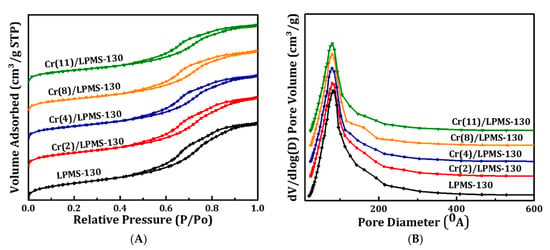
Figure 2.
(A) N2 sorption isotherms and (B) pore size distribution of Cr(y)/LPMS-130 prepared by varying the Cr loading wt %.
On the other hand, LPMS-100–130 samples exhibited a uniform and narrow pore size (Figure 1B), and LPMS-140 and LPMS-160 showed a broad pore distribution. Table 1 shows that the LPMS-130 sample possessed the highest pore volume with a narrow pore size distribution centered at 7.35 nm. Even though the LPMS-100 and LPMS-120 samples had a BET surface area that was higher than LPMS-130, their total pore volume and pore size were the smallest. In other words, treating samples at a hydrothermal temperature higher than 130 °C decreased the BET surface area and broadened the size distribution profile. Based on these results, the LPMS-130 sample displayed a moderate surface area with a high total pore volume and a narrow distribution of pore size; therefore, it was selected as the optimum catalyst support in this study.
Figure 2A,B displays the N2-isotherms and the distributions of the pore size of the Cr(y)/LPMS-130 prepared with different chromium concentrations. After Cr loading, the isotherms of the Cr(y)/LPMS-130 catalysts were similar to those of LPMS-130. This suggests that the mesoporous structure of the LPMS-130 sample was not defected by Cr impregnation. Moreover, both the BET surface area and the pore volume of the prepared Cr(y)/LPMS-130 catalysts decreased slightly as compared to the LPMS-130 bare support. This means that loading the LPMS-130 sample with chromium caused further filling of the mesoporous with CrOx species. The density of the Cr species on the surface of the prepared catalysts are listed in Table 2. This value refers to the degree of dispersion of Cr species on the LPMS support. Asghari et al. [] and Michorczyk et al. [] have reported that a lower chromium surface density indicates a good dispersion and increases the population of high valance Cr species. They concluded that one Cr atom per nm2 would lead to the formation of a monolayer coverage of well dispersed Cr species [,]. Based on the obtained results, the Cr(4)/LPMS-130 catalyst showed 1.051 Cr/nm2, indicating that a Cr surface density with a monolayer coverage of CrOx occurred at the highest dispersion of Cr species. Exceeding 4 wt % chromium loading increased the surface density of Cr (2.26 and 3.19 Cr(8)/LPMS-130 and Cr(11)/LPMS-130 catalysts, respectively), decreasing the surface dispersity and increasing the 3D bulk oxide species formation.

Table 2.
Textural properties of Cr(y)/LPMS-130 prepared with different chromium loading wt %.
Figure 3 displays the XRD patterns of the Cr(y)/LPMS-130 catalyst series prepared by impregnating LPMS-130 at different chromium loadings. From the reference patterns, the peaks at 2θ = 24.5, 33.6, 36.2, 41.5, 50.2, 54.9, 63.4, and 65.18° were assigned to the rhombohedral chromium oxide crystals (JCPDS 00-006-0504) [,]. Upon the impregnation of chromium ions, the characteristic peaks of the α-Cr2O3 phase were detected in all synthesized samples. The intensity of the α-Cr2O3 diffraction peaks increased by increasing the chromium content from 2 to 11 wt %. From the textural properties presented in Table 1, it can be seen that the crystallite size of Cr2O3 particles (calculated using Scherer’s equation from XRD patterns at 2Θ = 55.10°) is in the range of 12–19 nm for the synthesized catalysts.
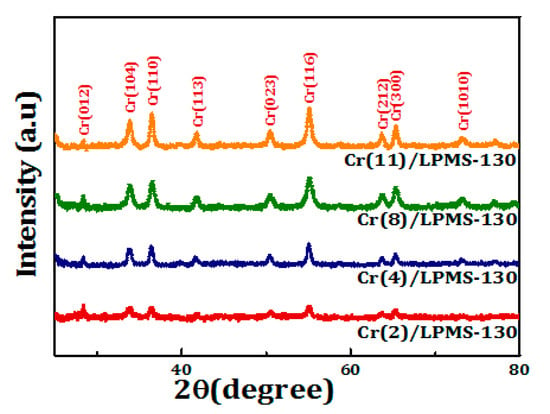
Figure 3.
XRD patterns of Cr(y)/LPMS-130 prepared with varying chromium loadings.
The internal structure and morphology of LPMS-130 and synthesized Cr(y)/LPMS-130 catalysts with 4 and 8 wt % Cr were investigated by TEM, and the obtained images are presented in Figure 4. The TEM images of the LPMS-130 sample shown in Figure 4A(a),B(a’) reveal the formation of large-pore mesoporous silica nanoparticles that lack long-term ordering. On the other hand, upon loading Cr with 4 wt % (Figure 4A(b),B(b’)), the TEM images of Cr(4)/LPMS-130 revealed a good dispersion and very fine Cr species that formed on the surface of LPMS-130. The spherical morphology of the CrOx species could be clearly observed in the higher-magnification TEM images with a maximum size of 22 nm. The TEM images of the higher Cr content sample of 8 wt % are shown in Figure 4A(c),B)(c’)), which illustrate an agglomeration of the Cr species on the surface of the LPMS-130 support, where the Cr species average size was around 200 nm.
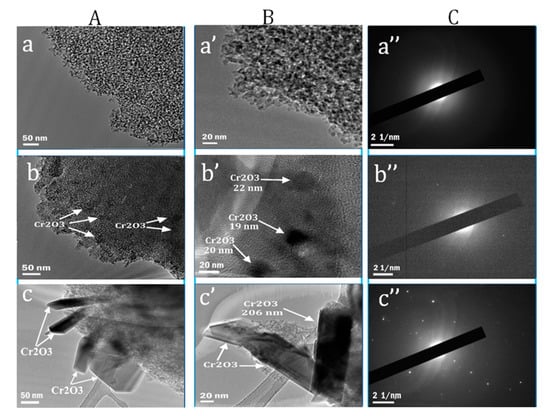
Figure 4.
(A) Low-magnification TEM images of Cr(y)/LPMS-130 with different chromium loadings: y = (a) 0, (b) 4, and (c) 8. (B) High-magnification images of Cr(y)/LPMS-130 with different chromium loadings: y = (a’) 0, (b’) 4, and (c’) 11. (C) SAED images of Cr(y)/LPMS-130 with different chromium loadings: y = (a’’) 0, (b’’) 4, and (c’’) 8.
Selected area electron diffraction patterns (SAED) for bare LPMS-130, Cr(4)/LPMS-130, and Cr(8)/LPMS-130 are displayed in Figure 4C(a”–c”), respectively. It is clear that LPMS-130 does not have spot patterns, suggesting the amorphous character of mesoporous silica in the absence of any ordering of the porous structure. Upon loading 4 wt % CrOx species, the SAED did not show spot patterns despite the existence of CrOx nanocrystals, which might be due to their fine particle size. A further increase of Cr loading to 8 wt % showed a spot poly-crystalline SAED pattern due to the formation of large particle size CrOx nanoparticles >200 nm. Based on TEM observations, with an up to 4 wt % Cr loading, CrOx species were formed in uniform and small size particles, but a further increase to 8 wt % led to the increase in the size of the CrOx species along with further aggregation. Therefore, catalysts loaded with 4 wt % Cr possessed a high dispersion of chromium species with consistent morphology and a uniform size of particles.
In order to investigate the dispersity of Cr species over the LPMS-130 mesoporous silica surface, SEM imaging and EDX elemental mapping were conducted on the LPMS-130, Cr(4)/LPMS-130, and Cr(8)/LPMS-130 samples and are presented in Figure 5. It is clear from Figure 5b,c (green) that the CrOx species were highly dispersed on the LPMS-130 mesoporous silica support in Cr(4)/LPMS-130 and Cr(8)/LPMS-130. However, the Cr(8)/LPMS-130 samples experienced agglomeration, as clearly observed from the greater intensity of the green dots, while the Cr(4)/LPMS-130 sample possessed a homogeneous dispersity of CrOx species on the LPMS support surface. Homogeneous dispersity as well as a fine size of CrOx particles are key factors governing the catalytic activity of metal oxide-supported catalysis.
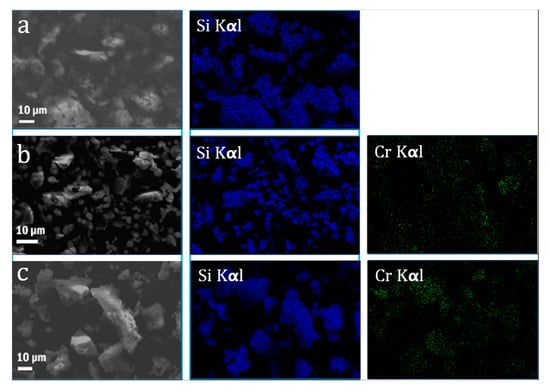
Figure 5.
SEM images and EDX elemental mapping (chromium (green); silicon (blue)) of Cr(y)/LPMS-130 prepared with different chromium loadings: (a) 0, (b) 4, and (c) 8 wt %.
X-ray photoelectron spectroscopy (XPS) was utilized to elucidate the oxidation states of Cr species on the surface of the prepared catalysts. The XPS spectra of Cr(y)/LPMS-130 (y = 2–11 wt %) samples are shown in Figure 6. The Cr2p spectra were deconvoluted using the Gaussian fitting method to calculate the composition of different oxidation states of Cr species, and the results are given in Table 3. It can be seen that the XPS survey spectra of the Cr(4)/LPMS-130 catalyst shown in Figure 6A illustrate that the surface of the Cr(y)/LPMS-130 sample contains Si, O, C, and Cr elements. The peaks located at 576, 529.6, 284.6, 153, and 103.4 eV were assigned to Cr2p, O1s, C1s, Si2s, and Si2p, respectively.

Figure 6.
(A) XPS survey scan of Cr(4)/LPMS-130. (B) Cr2p XPS spectrum of Cr(y)/LPMS-130, prepared with various Cr loadings: (B-a) 4, (B-b) 8, and (B-c) 11 Cr wt %.

Table 3.
XPS data of Cr(y)/LPMS-130 (x = 4, 8, and 11 wt %) catalysts.
The Cr2p spectra of the three samples (Figure 6B-a–B-c) showed two obvious peaks centered at ~575 and ~577 eV, which correspond to Cr2p3/2 and Cr2p1/2, respectively. These XPS peaks further divided into two other peaks. For these samples, the peaks at 577.6 and 586.63 eV characterize the Cr2p3/2 and Cr2p1/2 of the Cr6+ ions, while the peaks at 575.68 and 585.17 eV are assigned to the Cr2p3/2 and Cr2p1/2 of Cr3+. Wang et al. [], Mimura et al. [], Weckhuysen et al. [], and Al-Awadi et al. [,] have reported that the performance of chromium-based catalysts is intensely dependent on the Cr ions that dominate on the surface, whereas Cr species with a higher oxidation state show a higher performance during dehydrogenation reactions.
Based on the results in Table 3, it can be seen that all catalysts have a similar binding energy (BE) and the two oxidation states of chromium, Cr3+, and Cr6+ coexisted on the surface of the catalysts, but with variations in their Cr6+/Cr3+ ratios based on the Cr wt %. It is generally believed that reducible Cr species with a higher oxidation state (Cr6+) is key to superior catalytic activity during the light alkane dehydrogenation reactions [,,,,,,]. Ge et al. [] used ESR and UV-DRS to explore the active site of the ODH reaction of C2H6 with CO2 over CrOx/silica catalysts, and found that species with high oxidation states are essential for this reaction. Based on Table 3, the Cr6+/Cr3+ ratio increases with increasing chromium loading up to 4 wt %; however, with further increases up to 11 wt %, the ratio dropped again. Increasing Cr loading above 4% leads to decreased Cr6+ dispersion due to the formation of a non-active α-Cr2O3 phase. These results are consistent with those obtained by Al-Awadi et al. [] and Asghari et al. [], who found that the bulk Cr2O3 phase is dominant when Cr loading exceeds the monolayer coverage, which is 4% in our study. However, the samples with higher Cr concentrations (Cr(8)/LPMS-130 and Cr(11)/LPMS-130) possess a Cr surface density of more than 1 Cr atm/nm2 Cr-atom·nm−2 (2.26 and 3.185 Cr atm/nm2, respectively), which clearly indicates that, after exceeding the monolayer coverage of LPMS-130, the concentration and size of non-redox α-Cr2O3 phase are increased. This is confirmed by XRD results showing the intensity of the characteristic peaks of α-Cr2O3, in the XRD patterns increased by increasing chromium content. On the other hand, the presence of a high concentration of non-active Cr species at high Cr content does not make all reducible Cr species accessible to reactants, which also has a negative effect on catalytic activity. Consequently, the catalyst with 4 wt % exhibited the highest Cr6+/Cr3+ ratio with a value of 1.388. The domination of Cr6+ in the Cr(4)/LPMS-130 proposes a high catalytic performance toward the ODH of ethane with CO2.
Diffuse reflectance UV-Vis spectroscopy gives more information about the nature and valance of chromium species. The DR-UV/Vis spectra of Cr(y)/LPMS-130(x = 2, 4, 8, and 11 wt %) catalysts are shown in Figure 7A. It can be seen that all catalysts showed adsorption bands centered at 260 and 370 nm, which have been assigned to the O2– → Cr6+ charge transfer transition of chromate species in tetrahedral coordination [,,]. All samples showed a shoulder at ~415 nm that can be attributed to the dichromate or poly-chromate arrangement that interacted with the support [,]. The bands at 470 and 600 nm, on the other hand, are due to the d–d transitions of Cr3+ species in the octahedral symmetry [,,,,,]. It is obvious that the intensity of the Cr6+ band differs with varying chromium concentrations, where it increased with chromium loading up to 4 wt %. Any further increment of chromium content to 8 and 11 wt % resulted in a reduction of the intensity of the Cr6+ band associated with higher Cr3+ intensity due to the Cr2O3 phase formation. These results are consistent with those obtained from XPS measurements, where the Cr6+ is the dominant Cr species in the Cr(4)/LPMS-130 catalyst.
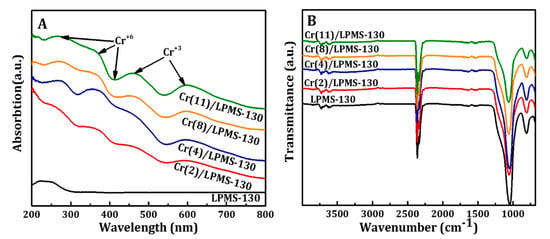
Figure 7.
(A) UV-Vis-DR spectra and (B) FTIR patterns of Cr(y)/LPMS-130 at various Cr loading wt %.
The FTIR spectra of the Cr(y)/LPMS-130 catalysts were measured in the 680–4000 cm−1 range and are displayed in Figure 7B. The presence of silica can be confirmed by the absorption bands at 1090 and 810 cm−1, which are related to the symmetric vibrations of Si–O–Si linkage. The lack of Cr absorption bands at 905 cm−1, which are ascribed to Cr–O vibration from Cr6+species, is due to its overlapping with the silica vibration band.
The band observed at about 1636 cm−1 is assigned to physically adsorbed water []. The band observed at 2360 cm−1 is a characteristic peak of CO2, which may have been adsorbed from the atmosphere [,]. It can be observed that there are no significant differences in the prepared samples with different chromium concentrations since similar FTIR peaks were observed.
2.2. Catalytic Activity of Cr(y)/LPMS-130 Catalysts
The catalytic performance of Cr(y)/LPMS-130 catalysts was investigated in the ODH of ethane with carbon dioxide at three different reaction temperatures, and the results are presented in Figure 8A–C. The primary product, ethylene, was produced over all tested Cr(y)/LPMS-130 catalysts with a high selectivity in the range between 90 and 93% (Figure 8C). In addition to ethylene, a small amount of methane was produced. Methane was mainly formed by the hydrocracking reaction of both ethane and ethylene. For each catalyst, the C2H6 conversion and C2H4 yield increased markedly with the increase of the reaction temperature due to the reaction’s endothermicity. On the other hand, the selectivity to C2H4 slightly dropped with temperature, suggesting that cracking reactions are favorable at high reaction temperatures. Moreover, the experimental results obviously indicate that chromium loading is also crucial for catalytic performance. The conversion of ethane and the yield of ethylene increased with the increase of the chromium loading of Cr(y)/LPMS-130 up to 4 wt % Cr, and then gradually decreased with higher chromium loadings of 8 and 11 wt % (Figure 8A,B). The drop in conversion observed at a higher Cr content was caused mainly by the formation of chromium oxide crystals. In many reactions, including the ODH of ethane, α-Cr2O3 particles were found to be less active than the dispersed Cr species. The XRD, UV/vis-DRS, and TEM suggested that crystalline α-Cr2O3 is produced predominantly with increasing Cr content. Over the course of the scanned temperatures, Cr(4)/LPMS-130 had a superior catalytic activity with the ODH of ethane with CO2.
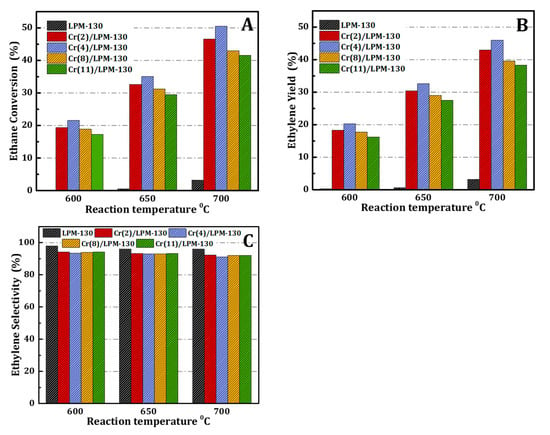
Figure 8.
Effects of Cr loading on (A) C2H6 conversion and (B,C) C2H4 yield and selectivity, respectively, for Cr(y)/LPMS-130 catalysts at various reaction temperatures.
The enhancement in C2H6 conversion and C2H4 yield can be explained by the superior chromium species dispersion and the higher concentration of Cr6+ species. As mentioned before, the reducible Cr6+ was the most active species in the ODH of ethane with carbon dioxide.
Generally, the ODH reaction over the Cr-based catalysts is believed to follow a Mars-Van Krevelen (redox type) mechanism [,,,,,]. This mechanism suggests that adsorbed C2H6 reacts with lattice oxygen atoms of CrO3 to produce C2H4 along with water in the initial step and Cr3+ species, resulting from the reduction of Cr6+ species by ethane.
The reduced chromium oxide (Cr3+) species are then re-oxidized by adsorbed dissociated CO2 in a separate step.
In addition to the ODH reaction, it is observed that ethylene can be simultaneously produced by the dehydrogenation of ethane.
However, in the presence of CO2, hydrogen that is produced by the direct dehydrogenation of ethane is consumed by the reverse water–gas shift reaction (RWGS), which shifts the reaction equilibrium towards more ethylene production.
According to the above, carbon dioxide can contribute either directly in ethane dehydrogenation via the donation of oxygen or by removing hydrogen in the RWGS reaction. Therefore, the role of carbon dioxide in ethane dehydrogenation is either as a lattice oxygen supplier, which keeps the concentration of Cr6+ as high as possible, or as a consumer of hydrogen by the RWGS reaction.
The other promoting role of CO2 in this reaction might be the prohibiting coke formation by the Boudouard reaction and its assistance in the rapid desorption of ethylene, which enhances catalyst stability [,,].
As a result, the domination of reducible Cr6+ within the prepared catalysts is crucial for the ODH reaction [,]. Previously presented BET, SEM, TEM, XPS, and UV/vis-DRS measurements clearly show that CrOx species, formed on the surface of LPMS-130 support, are highly dispersed and that Cr6+ species are dominant. Moreover, the XPS results reveal that the highest Cr6+/Cr3+ ratio was obtained for the Cr(4)/LPMS-130 sample, which is in agreement with their superior catalytic activity. The catalyst displayed a C2H6 conversion of 50.5% and a C2H4 yield of 46.01% at 700 °C. In contrast, the Cr(11)/LPMS-130 catalyst exhibited a lower activity, even though it had the highest amount of Cr6+ species. Herein, the type of Cr6+ species has to be considered as another possible factor in the dehydrogenation reaction. Based on the literature, there are two types of Cr6+ species formed and dispersed on fresh catalysts: surface Cr6+ species, which are dispersed on α-Cr2O3 surfaces, and Cr6+ species interacting with the framework of siliceous support [,,,]. It is well known that the former Cr6+ species are unfavorable and have a higher tendency to form α-Cr2O3. Furthermore, Cr6+ interacting with the support matrix is desirable because it is more stable []. However, the distribution of Cr6+ species between the surface and inside the matrix is crucial for the ODH of ethane reaction. This may be the reason why Cr(11)/LPMS-130 exhibited relatively low activity, even though it had a higher amount of reducible Cr6+ as compared with the Cr(4)/LPMS-130 catalyst.
The ODH of ethane with CO2 for the Cr(4)/LPMS-130 catalyst was investigated at different values of gas hourly space velocity (GHSV). (GHSV is obtained by dividing the total flow rate by the bed volume.) The experimental results are presented in Figure 9. The space velocity was changed by varying the total reactant flow rate while keeping the same compositions. Both ethane conversions and ethylene yields decreased, whereas ethylene selectivity increased with increasing space velocity. However, such results can be correlated with the decrease of the residence time with increasing space velocity; hence, the reactants need more thermal energy and preheating for the dehydrogenation reaction.
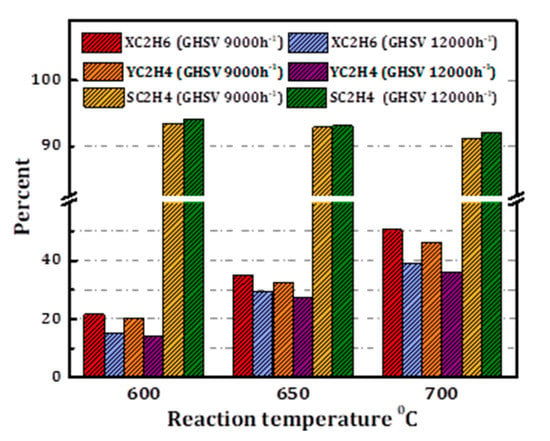
Figure 9.
Effects of gas hourly space velocity (GHSV) on C2H6 conversion and C2H4 yield and selectivity for the Cr(4)/LPMS-130 catalyst at various reaction temperatures.
Finally, the stability of the Cr(4)/LPMS-130 catalyst was investigated where ethane dehydrogenation with CO2 was run continuously for 700 min, and the results are shown in Figure 10. It can be observed that both C2H6 conversion and C2H4 yield decreased slowly with reaction time, suggesting a slight deactivation of the catalyst. In contrast, C2H4 selectivity slightly increased and remained above 90%. Reduction of redox Cr species in addition to coke formation may contribute to the deactivation of catalysis [,,]. Even after 700 min of reaction stream, a high C2H4 yield, more than 30%, could still obtained for the tested catalyst.
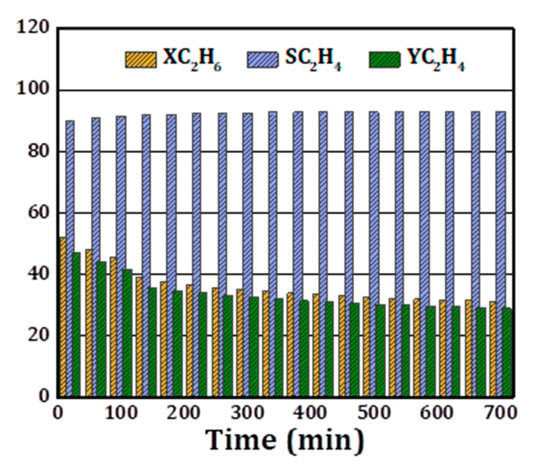
Figure 10.
Variation of C2H6 conversion C2H4 yield and selectivity with time-on-stream over the Cr(4)/LPMS-130 catalyst.
3. Experimental
3.1. Materials
Tetraethyl orthosilicate [Si(OC2H5)4, TEOS, ≥98%] (silica precursor) and a Triblock copolymer, PEO-PPO-PEO (Pluronic P123, molecular weight = 5800, EO20PO70EO20) (structure-directing template), were obtained from Sigma-Aldrich (Steinheim, Germany). Chromium nitrate nonahydrate [Cr(NO3)3·9H2O] (chromium precursor) with analytical grades was obtained from Alfa Aesar (Karlsruhe, Germany). All other reagents were also obtained from Sigma-Aldrich and used as received without further purification.
3.2. Catalyst Preparation
The large-pore mesoporous silica support was synthesized according to the literature []. Briefly, 2.0 g of Pluronic P123 was dissolved in 81.5 mL of H2O and 3.5 mL of 37% HCl. The solution was stirred until P123 was completely dissolved. Subsequently, 2.8 mL of n-butanol was added with continuous stirring for an hour. After that, 5.19 mL of TEOS was added dropwise to the above solution. The resulting mixture was continuously stirred at 35 °C for 24 h. The obtained mixture was then introduced into a stainless autoclave equipped with a Teflon inner tube and aged at different temperatures for 24 h under static hydrothermal conditions. The precipitated material was filtered, washed several times, and then dried in a vacuum oven overnight. The obtained material was crushed and then heated up to 550 °C at a rate of 2 °C/min to remove the template. Subsequently, the material was calcined at the same temperature for 4 h. The final material was LPMS-x, where “x” denotes the aging temperature in °C.
The supported CrOx catalysts were synthesized by an incipient wetness impregnation method. The synthesized support was impregnated with an aqueous solution that contained an appropriate amount of chromium nitrate. The mixture was stirred for 3 h and then dried before being calcined at 650 °C for 6 h. The prepared catalysts were denoted as Cr(y)/LPMS-x, where “y” represents the total chromium content in wt % of Cr.
3.3. Catalyst Characterization
Characterization techniques such as XRD, BET, TEM, SEM, XPS, FTIR, and DR-UV/vis spectroscopy were employed to clearly indicate the surface chemistry, structure, and morphology of the synthesized catalysts.
3.4. Catalytic Evaluation
Oxidative dehydrogenation of C2H6 with CO2 on the surface of the Cr(y)/LPMS-x catalysts was carried out in the experimental system depicted in Figure 11. The experiments were performed by utilizing 0.3 g of the synthesized catalysts placed between glass wool layers. Before starting the reaction, the catalyst was preheated in situ at 600 °C in an air atmosphere for about 0.5 h. The reactant mixture consisting of 10% C2H6, 50% CO2, and N2 as a balance was fed into the reactor at a total flow rate of 45 mL/min. The ODH of C2H6 with CO2 was conducted at atmospheric pressure and in a temperature range of 600–700 °C. The analysis was started 20 min after the beginning of the dehydrogenation reaction. The dehydrogenation products, as well as the unconverted reactants, were analyzed by an online Agilent gas chromatograph.

Figure 11.
Experimental setup for the oxidative dehydrogenation (ODH) of C2H6 with CO2.
The conversion of C2H6, the yield of C2H4, and the selectivity of the products were calculated based on the following equations:
where ni is the number of moles of compound i.
4. Conclusions
The temperature of hydrothermal treatment is a key factor that determines the final structural and textural properties of large-pore mesoporous silica nanomaterial. Among the different hydrothermal temperatures, the sample prepared at 130 °C exhibited the highest pore volume, a narrow pore size distribution, and a reasonable BET surface area. The Cr(y)/LPMS-130 catalysts obtained by the impregnation method showed good catalytic activity with the dehydrogenation of ethane with CO2. Over the most active Cr(4)/LPMS-130 catalyst, the conversion of ethane and the selectivity to ethylene were 50.5 and 91.11%, respectively, at 700 °C. The high catalytic activity of Cr(4)/LPMS-130 has been related to the high dispersed chromium species and its high Cr6+/Cr3+ ratio on the surface. The promotion effect of the presence of CO2 on the yield of ethylene observed over the mesoporous silica supported chromium oxide catalysts is not only attributed to the ODH of ethane but can also be related to the dehydrogenation ethane with its coupling by the RWGS reaction.
Supplementary Materials
The following are available online at https://www.mdpi.com/2073-4344/10/1/97/s1, Table S1: Comparison of catalytic performance of various Cr-based catalysts for ODH of ethane with CO2.
Author Contributions
Conceptualization, writing-review editing: A.E.A. and S.M.A.-Z. Investigation, writing-original draft, writing-review editing: A.S.A.-A., A.M.E.-T., and A.E.A. Methodology and formal analysis: A.S.A.-A. and A.M.E.-T. All authors have read and agreed to the published version of the manuscript.
Funding
The authors would like to acknowledge the support provided by King Saud University through the Research Supporting Project no. (RSP-2019/37) at King Saud University, Riyadh, Saudi Arabia.
Conflicts of Interest
The authors declare no conflict of interest.
References
- Gärtner, C.A.; van Veen, A.C.; Lercher, J.A. Oxidative Dehydrogenation of Ethane: Common Principles and Mechanistic Aspects. ChemCatChem 2013, 5, 3196–3217. [Google Scholar] [CrossRef]
- Koirala, R.; Buechel, R.; Pratsinis, S.E.; Baiker, A. Silica is preferred over various single and mixed oxides as support for CO2-assisted cobalt-catalyzed oxidative dehydrogenation of ethane. Appl. Catal. A Gen. 2016, 527, 96–108. [Google Scholar] [CrossRef]
- Bhasin, M.M.; McCain, J.H.; Vora, B.V.; Imai, T.; Pujadó, P.R. Dehydrogenation and oxydehydrogenation of paraffins to olefins. Appl. Catal. A 2001, 221, 397–419. [Google Scholar] [CrossRef]
- Ren, T.; Patel, M.; Blok, K. Olefins from conventional and heavy feedstocks: Energy use in steam cracking and alternative processes. Energy 2006, 31, 425–451. [Google Scholar] [CrossRef]
- Zimmermann, R.W.H. Ethylene. In Ullmann’s Encyclopedia of Industrial Chemistry; Wiley-VCH Verlag GmbH & Co. KGaA: Weinheim, Germany, 2009; Volume 13, pp. 465–529. [Google Scholar]
- Kung, H.H. Oxidative dehydrogenation of light (C2 to C4) alkanes. In Advances in Catalysis; Eley, D.D., Pines, H., Haag, W.O., Eds.; Academic Press: Cambridge, MA, USA, 1994; Volume 40, pp. 1–38. [Google Scholar]
- Wang, S.; Murata, K.; Hayakawa, T.; Hamakawa, S.; Suzuki, K. Dehydrogenation of ethane with carbon dioxide over supported chromium oxide catalysts. Appl. Catal. A Gen. 2000, 196, 1–8. [Google Scholar] [CrossRef]
- Held, A.; Kowalska, J.; Nowińska, K. Nitrous oxide as an oxidant for ethane oxydehydrogenation. Appl. Catal. B Environ. 2006, 64, 201–208. [Google Scholar] [CrossRef]
- Deng, S.; Li, H.; Li, S.; Zhang, Y. Activity and characterization of modified Cr2O3/ZrO2 nano-composite catalysts for oxidative dehydrogenation of ethane to ethylene with CO2. J. Mol. Catal. A Chem. 2007, 268, 169–175. [Google Scholar] [CrossRef]
- Liu, L.; Li, H.; Zhang, Y. Mesoporous silica-supported chromium catalyst: Characterization and excellent performance in dehydrogenation of propane to propylene with carbon dioxide. Catal. Commun. 2007, 8, 565–570. [Google Scholar] [CrossRef]
- Michorczyk, P.; Pietrzyk, P.; Ogonowski, J. Preparation and characterization of SBA-1–supported chromium oxide catalysts for CO2 assisted dehydrogenation of propane. Microporous Mesoporous Mater. 2012, 161, 56–66. [Google Scholar] [CrossRef]
- Wu, R.; Xie, P.; Cheng, Y.; Yue, Y.; Gu, S.; Yang, W.; Miao, C.; Hua, W.; Gao, Z. Hydrothermally prepared Cr2O3–ZrO2 as a novel efficient catalyst for dehydrogenation of propane with CO2. Catal. Commun. 2013, 39, 20–23. [Google Scholar] [CrossRef]
- Shi, X.; Ji, S.; Wang, K. Oxidative Dehydrogenation of Ethane to Ethylene with Carbon dioxide over Cr–Ce/SBA-15 Catalysts. Catal. Lett. 2008, 125, 331–339. [Google Scholar] [CrossRef]
- Michorczyk, P.; Ogonowski, J.; Niemczyk, M. Investigation of catalytic activity of CrSBA-1 materials obtained by direct method in the dehydrogenation of propane with CO2. Appl. Catal. A Gen. 2010, 374, 142–149. [Google Scholar] [CrossRef]
- Baek, J.; Yun, H.J.; Yun, D.; Choi, Y.; Yi, J. Preparation of Highly Dispersed Chromium Oxide Catalysts Supported on Mesoporous Silica for the Oxidative Dehydrogenation of Propane Using CO2: Insight into the Nature of Catalytically Active Chromium Sites. ACS Catal. 2012, 2, 1893–1903. [Google Scholar] [CrossRef]
- Al-Awadi, A.S.; El-Toni, A.M.; Alhoshan, M.; Khan, A.; Labis, J.P.; Al-Fatesh, A.; Abasaeed, A.E.; Al-Zahrani, S.M. Impact of precursor sequence of addition for one-pot synthesis of Cr-MCM-41 catalyst nanoparticles to enhance ethane oxidative dehydrogenation with carbon dioxide. Ceram. Int. 2019, 45, 1125–1134. [Google Scholar] [CrossRef]
- Asghari, E.; Haghighi, M.; Rahmani, F. CO2 Oxidative Dehydrogenation of Ethane to Ethylene over Cr/MCM-41 Nanocatalyst Synthesized via Hydrothermal/Impregnation Methods: Influence of Chromium Content on Catalytic Properties and Performance. J. Mol. Catal. A Chem. 2016, 418, 115–124. [Google Scholar] [CrossRef]
- Takehira, K.; Ohishi, Y.; Shishido, T.; Kawabata, T.; Takaki, K.; Zhang, Q.; Wang, Y. Behavior of active sites on Cr-MCM-41 catalysts during the dehydrogenation of propane with CO2. J. Catal. 2004, 224, 404–416. [Google Scholar] [CrossRef]
- Kruk, M. Access to Ultralarge-Pore Ordered Mesoporous Materials through Selection of Surfactant/Swelling-Agent Micellar Templates. Acc. Chem. Res. 2012, 45, 1678–1687. [Google Scholar] [CrossRef]
- Corma, A.; Kan, Q.; Navarro, M.T.; Pérez-Pariente, J.; Rey, F. Synthesis of MCM-41 with Different Pore Diameters without Addition of Auxiliary Organics. Chem. Mater. 1997, 9, 2123–2126. [Google Scholar] [CrossRef]
- Horcajada, P.; Rámila, A.; Pérez-Pariente, J.; Vallet-Regí, M. Influence of pore size of MCM-41 matrices on drug delivery rate. Microporous Mesoporous Mater. 2004, 68, 105–109. [Google Scholar] [CrossRef]
- Wang, W.; Liu, P.; Zhang, M.; Hu, J.; Xing, F. The pore structure of phosphoaluminate cement. Open J. Compos. Mater. 2012, 2, 104–112. [Google Scholar] [CrossRef]
- Sing, K.S.W.; Everett, D.H.; Haul, R.A.W.; Moscou, L.; Pierotti, R.A.; Rouquerol, J.; Siemieniewska, T. Reporting Physisorption data for gas/solid systems. In Handbook of Heterogeneous Catalysis; Wiley-VCH Verlag GmbH & Co. KGaA: Weinheim, Germany, 2008; pp. 1217–1230. [Google Scholar]
- Michorczyk, P.; Ogonowski, J.; Zeńczak, K. Activity of chromium oxide deposited on different silica supports in the dehydrogenation of propane with CO2—A comparative study. J. Mol. Catal. A Chem. 2011, 349, 1–12. [Google Scholar] [CrossRef]
- Rahmani, F.; Haghighi, M.; Mahboob, S. CO2 -enhanced dehydrogenation of ethane over sonochemically synthesized Cr/clinoptilolite-ZrO2 nanocatalyst: Effects of ultrasound irradiation and ZrO2 loading on catalytic activity and stability. Ultrason. Sonochem. 2016, 33, 150–163. [Google Scholar] [CrossRef] [PubMed]
- Mimura, N.; Okamoto, M.; Yamashita, H.; Oyama, S.T.; Murata, K. Oxidative Dehydrogenation of Ethane over Cr/ZSM-5 Catalysts Using CO2 as an Oxidant. J. Phys. Chem. B 2006, 110, 21764–21770. [Google Scholar] [CrossRef] [PubMed]
- Weckhuysen, B.M.; Schoonheydt, R.A. Alkane dehydrogenation over supported chromium oxide catalysts. Catal. Today 1999, 51, 223–232. [Google Scholar] [CrossRef]
- Al-Awadi, A.S.; El-Toni, A.M.; Al-Zahrani, S.M.; Abasaeed, A.E.; Alhoshan, M.; Khan, A.; Labis, J.P.; Al-Fatesh, A. Role of TiO2 nanoparticle modification of Cr/MCM41 catalyst to enhance Cr-support interaction for oxidative dehydrogenation of ethane with carbon dioxide. Appl. Catal. A Gen. 2019, 584, 117114. [Google Scholar] [CrossRef]
- Rahmani, F.; Haghighi, M.; Amini, M. The beneficial utilization of natural zeolite in preparation of Cr/clinoptilolite nanocatalyst used in CO2-oxidative dehydrogenation of ethane to ethylene. J. Ind. Eng. Chem. 2015, 31, 142–155. [Google Scholar] [CrossRef]
- Ge, X.; Zhu, M.; Shen, J. Catalytic performance of silica-supported chromium oxide catalysts in ethane dehydrogenation with carbon dioxide. React. Kinet. Catal. Lett. 2002, 77, 103–108. [Google Scholar] [CrossRef]
- Mimura, N.; Takahara, I.; Inaba, M.; Okamoto, M.; Murata, K. High-performance Cr/H-ZSM-5 catalysts for oxidative dehydrogenation of ethane to ethylene with CO2 as an oxidant. Catal. Commun. 2002, 3, 257–262. [Google Scholar] [CrossRef]
- De Rossi, S.; Pia Casaletto, M.; Ferraris, G.; Cimino, A.; Minelli, G. Chromia/zirconia catalysts with Cr content exceeding the monolayer. A comparison with chromia/alumina and chromia/silica for isobutane dehydrogenation. Appl. Catal. A Gen. 1998, 167, 257–270. [Google Scholar] [CrossRef]
- Zhao, X.; Wang, X. Synthesis, characterization and catalytic application of Cr–SBA-1 mesoporous molecular sieves. J. Mol. Catal. A Chem. 2007, 261, 225–231. [Google Scholar] [CrossRef]
- Weckhuysen, B.M.; Verberckmoes, A.A.; Debaere, J.; Ooms, K.; Langhans, I.; Schoonheydt, R.A. In situ UV–Vis diffuse reflectance spectroscopy—On line activity measurements of supported chromium oxide catalysts: Relating isobutane dehydrogenation activity with Cr-speciation via experimental design. J. Mol. Catal. A Chem. 2000, 151, 115–131. [Google Scholar] [CrossRef]
- Weckhuysen, B.M.; Wachs, I.E.; Schoonheydt, R.A. Surface Chemistry and Spectroscopy of Chromium in Inorganic Oxides. Chem. Rev. 1996, 96, 3327–3350. [Google Scholar] [CrossRef] [PubMed]
- Weckhuysen, B.M.; Verberckmoes, A.A.; Baets, A.R.D.; Schoonheydt, R.A. Diffuse Reflectance Spectroscopy of Supported Chromium Oxide Catalysts: A Self-Modeling Mixture Analysis. J. Catal. 1997, 166, 160–171. [Google Scholar] [CrossRef]
- Ayari, F.; Mhamdi, M.; Álvarez-Rodríguez, J.; Ruiz, A.R.G.; Delahay, G.; Ghorbel, A. Selective catalytic reduction of NO with NH3 over Cr-ZSM-5 catalysts: General characterization and catalysts screening. Appl. Catal. B Environ. 2013, 134, 367–380. [Google Scholar] [CrossRef]
- Cavani, F.; Koutyrev, M.; Trifirò, F.; Bartolini, A.; Ghisletti, D.; Iezzi, R.; Santucci, A.; Del Piero, G. Chemical and Physical Characterization of Alumina-Supported Chromia-Based Catalysts and Their Activity in Dehydrogenation of Isobutane. J. Catal. 1996, 158, 236–250. [Google Scholar] [CrossRef]
- Puurunen, R.L.; Weckhuysen, B.M. Spectroscopic Study on the Irreversible Deactivation of Chromia/Alumina Dehydrogenation Catalysts. J. Catal. 2002, 210, 418–430. [Google Scholar] [CrossRef]
- Cheng, Y.; Zhang, F.; Zhang, Y.; Miao, C.; Hua, W.; Yue, Y.; Gao, Z. Oxidative dehydrogenation of ethane with CO2 over Cr supported on submicron ZSM-5 zeolite. Chin. J. Catal. 2015, 36, 1242–1248. [Google Scholar] [CrossRef]
- Abdollahifar, M.; Haghighi, M.; Babaluo, A.A. Syngas production via dry reforming of methane over Ni/Al2O3–MgO nanocatalyst synthesized using ultrasound energy. J. Ind. Eng.Chem. 2014, 20, 1845–1851. [Google Scholar] [CrossRef]
- Khoshbin, R.; Haghighi, M. Urea-nitrate combustion synthesis and physicochemical characterization of CuO-ZnO-Al2O3 nanoparticles over HZSM-5. Chin. J. Inorg. Chem. 2012, 28, 1967–1978. [Google Scholar]
- Wang, S.; Murata, K.; Hayakawa, T.; Hamakawa, S.; Suzuki, K. Oxidative dehydrogenation of ethane by carbon dioxide over sulfate-modified Cr2O3/SiO2 catalysts. Catal. Lett. 1999, 63, 59–64. [Google Scholar] [CrossRef]
- Shishido, T.; Shimamura, K.; Teramura, K.; Tanaka, T. Role of CO2 in dehydrogenation of propane over Cr-based catalysts. Catal. Today 2012, 185, 151–156. [Google Scholar] [CrossRef]
- Shi, X.; Ji, S.; Wang, K.; Li, C. Oxidative Dehydrogenation of Ethane with CO2 over Novel Cr/SBA-15/Al2O3/FeCrAl Monolithic Catalysts. Energy Fuels 2008, 22, 3631–3638. [Google Scholar] [CrossRef]
- Longya, X.; Jinxiang, L.; Yide, X.; Hong, Y.; Qingxia, W.; Liwu, L. The suppression of coke deposition by the modification of Mn on Fe/silicalite-2 catalyst in dehydrogenation of C2H6 with CO2. Appl. Catal. A Gen. 2000, 193, 95–101. [Google Scholar] [CrossRef]
- Michorczyk, P.; Ogonowski, J.; Kuśtrowski, P.; Chmielarz, L. Chromium oxide supported on MCM-41 as a highly active and selective catalyst for dehydrogenation of propane with CO2. Appl. Catal. A Gen. 2008, 349, 62–69. [Google Scholar] [CrossRef]
- Rao, T.V.M.; Yang, Y.; Sayari, A. Ethane dehydrogenation over pore-expanded mesoporous silica supported chromium oxide: 1. Catalysts preparation and characterization. J. Mol. Catal. A Chem. 2009, 301, 152–158. [Google Scholar] [CrossRef]
- Zhu, Q.; Takiguchi, M.; Setoyama, T.; Yokoi, T.; Kondo, J.N.; Tatsumi, T. Oxidative dehydrogenation of propane with CO2 over Cr/H [B] MFI catalysts. Catal. Lett. 2011, 141, 670–677. [Google Scholar] [CrossRef]
- Nijhuis, T.A.; Tinnemans, S.J.; Visser, T.; Weckhuysen, B.M. Towards real-time spectroscopic process control for the dehydrogenation of propane over supported chromium oxide catalysts. Chem. Eng. Sci. 2004, 59, 5487–5492. [Google Scholar] [CrossRef]
- Yan, W.; Ramanathan, A.; Ghanta, M.; Subramaniam, B. Towards highly selective ethylene epoxidation catalysts using hydrogen peroxide and tungsten- or niobium-incorporated mesoporous silicate (KIT-6). Catal. Sci. Technol. 2014, 4, 4433–4439. [Google Scholar] [CrossRef]
© 2020 by the authors. Licensee MDPI, Basel, Switzerland. This article is an open access article distributed under the terms and conditions of the Creative Commons Attribution (CC BY) license (http://creativecommons.org/licenses/by/4.0/).